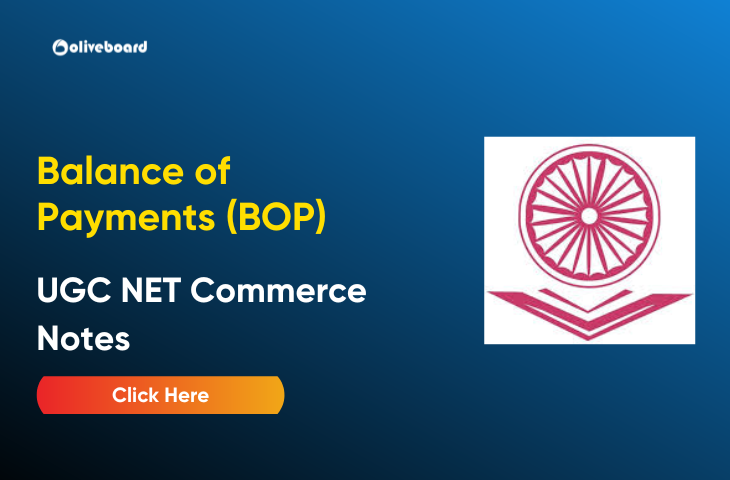The Balance of Payments (BOP) is a crucial economic indicator that tracks the inflow and outflow of foreign exchange in a country. It provides a comprehensive overview of a nation’s economic transactions with the rest of the world, including imports, exports, investments, and financial transfers. For UGC NET Commerce aspirants, understanding the structure and components of BOP such as the current account, capital account, and financial account is essential for both theoretical knowledge and practical application in economic analysis. By analyzing BOP, policymakers can assess the health of the economy, manage exchange rates, and devise strategies for sustainable growth.
Click Here to Check UGC NET Notification 2024
What is Balance of Payments (BOP)?
Balance of Payments (BOP) helps track trade balances, capital flows, and financial movements across borders, highlighting its significance for economic policy, currency valuation, and global trade relations
- Comprehensive Economic Record: The BOP tracks all international economic transactions, including trade, investment, and financial transfers between a country and the rest of the world.
- Current Account: BOP records trade in goods and services, income from abroad, and unilateral transfers (e.g., remittances).
- Capital Account: It measures international transactions involving assets, such as foreign investments, loans, and debt repayments.
- Financial Account: It captures investments like Foreign Direct Investment (FDI) and portfolio investments, along with changes in financial assets across borders.
- Economic Policy Tool: Balance of Payment helps governments shape fiscal and monetary policies, manage trade imbalances, and ensure economic stability.
- Global Economic Indicator: The BOP provides insights into a country’s financial relations with the world and its ability to meet external obligations.
Check UGC NET Commerce Syllabus 2024
Components of Balance of Payments (BOP)
Balance of Payments (BOP) is generally categorized into three components: current account, capital account, and financial account. Let’s understand all the components of BOP in detail.
1. Current Account
- Goods and Services: Records exports and imports of tangible goods (e.g., machinery, food products) and services (e.g., insurance, travel). A trade surplus occurs when exports exceed imports, while a deficit happens when imports surpass exports.
- Income: Includes income earned from foreign investments (interest, dividends) and wages for work done abroad (remittances from migrant workers).
- Unilateral Transfers: Refers to one-way transfers such as remittances sent by expatriates, foreign aid, or charitable donations, with no reciprocal payments.
2. Capital Account
- Capital Transfers: Covers non-financial transactions such as the forgiveness of debt, transfers related to migration (e.g., property ownership), and the donation of non-financial assets like intellectual property.
- Acquisition/Disposal of Non-Produced, Non-Financial Assets: Involves transactions involving intangible assets like patents, copyrights, trademarks, and natural resource rights.
3. Financial Account
The Financial Account in the Balance of Payments (BOP) tracks a country’s international financial transactions involving ownership of financial assets. Here are its components
- Foreign Direct Investment (FDI): Long-term investments where foreign entities acquire a lasting interest in domestic companies (e.g., setting up branches, joint ventures, or buying shares that provide control).
- Portfolio Investment: Refers to the purchase of stocks, bonds, and other securities that do not provide a controlling interest in the companies, often short-term in nature.
- Other Investments: Covers loans, trade credits, and deposits. This is a diverse category that reflects various short-term and long-term financial transactions not captured by FDI or portfolio investment.
- Reserve Assets: Involves changes in a country’s central bank holdings of foreign exchange, gold reserves, and other financial assets used for monetary policy and exchange rate management.
How the Balance of Payments (BOP) is Balanced?
The Balance of Payments (BOP) is a comprehensive record of all the financial transactions made between a country and the rest of the world. In an ideal scenario, the BOP should balance out. However, it is rare to see exact equilibrium. Here’s how BOP balance is maintained:
1. Current Account and Financial Account:
- If a country runs a deficit in the current account, this is usually offset by a surplus in the financial account.
- A surplus in the financial account means that the country is receiving more foreign investments or loans than it is sending out.
- This helps to fund the current account deficit.
2. Capital Account Adjustments:
- The capital account generally has a minor role in balancing the BOP, but it can provide the necessary adjustments when large one-time transfers occur, such as debt forgiveness or large-scale transfers of assets.
3. Reserve Assets:
- A central bank or government may use reserve assets to balance any discrepancies in the BOP.
- When there is a deficit in the current or financial account, the central bank might draw on foreign exchange reserves to cover the imbalance, or in some cases, the country might borrow from foreign lenders or international financial institutions.
4. Market Mechanisms:
- The exchange rate often plays a vital role in balancing the BOP.
- For example, if a country faces a current account deficit, the currency value may depreciate, making exports cheaper and imports more expensive.
- This can help reduce the deficit by encouraging more exports and limiting imports, naturally correcting the balance over time.
5. Government Policy Interventions:
- Governments may also intervene through monetary and fiscal policies to correct imbalances in the BOP.
- For example, they might impose tariffs or import quotas to reduce the import bill or take steps to attract foreign investments to balance the financial account.
Balance of Payments (BOP) Conclusion
The Balance of Payments (BOP) is a comprehensive record of all economic transactions between a country and the rest of the world. It includes the current account, capital account, and financial account, each serving a distinct purpose in tracking trade, investments, and capital flows. Understanding the BOP is crucial for assessing a country’s economic health, as it reflects trade balances, foreign investments, and the movement of capital. Imbalances in the BOP can influence currency stability, economic policies, and long-term growth strategies. For UGC NET Commerce aspirants, mastering the BOP is essential for understanding global economic interactions and its impact on national economies.
UGC NET Commerce MCQ based on Balance of Payments (BOP)
Q1. Which of the following accounts is NOT a component of the Balance of Payments (BOP)?
a) Current Account
b) Capital Account
c) Revenue Account
d) Financial Account
Answer: c) Revenue Account
Q2. Which of the following transactions would NOT be recorded under the current account?
A) Export of machinery
B) Income from foreign investments
C) Foreign direct investment inflow
D) Remittances from abroad
Answer: C) Foreign direct investment inflow
Q3. In the context of the Balance of Payments, what does a capital account surplus signify?
A) The country is selling more goods and services to foreign markets than it imports
B) There is an excess of investment outflows compared to inflows
C) The country is receiving more capital transfers than it is sending out
D) The country is incurring a deficit in its current account
Answer: C) The country is receiving more capital transfers than it is sending out
Q4. A country experiencing a persistent BOP deficit is likely to see which of the following consequences?
A) Depreciation of the domestic currency
B) Increase in foreign exchange reserves
C) Rising foreign investments
D) Improvement in the current account balance
Answer: A) Depreciation of the domestic currency
Also Read:
- Get Free UGC NET Commerce Notes (Latest Pattern)
- Click here for monetary and fiscal policy commerce notes
- Click here for Foreign Exchange Management Act (FEMA), Study Notes
- Key Elements of Business Environment notes
- FDI and FPI study notes for UGC NET Commerce
- Role and Functions of the Reserve Bank of India (RBI)
Ans: The Balance of Payments (BOP) is a record of all economic transactions between a country and the rest of the world during a specific period. It includes imports, exports, investments, and loans. The BOP consists of three main accounts: the current account, capital account, and financial account. These help monitor a country’s economic stability, trade relationships, and financial health.
Ans: The BOP has three primary components:
– Current Account: Tracks trade in goods and services, income flows, and unilateral transfers.
– Capital Account: Includes capital transfers like debt forgiveness and asset sales.
– Financial Account: Captures foreign direct investments (FDI), portfolio investments, loans, and changes in reserve assets.
Ans: The current account of the BOP records a country’s trade in goods and services, income earned from abroad (such as dividends or wages), and unilateral transfers (like remittances). A surplus in the current account means that a country is exporting more than it imports, while a deficit indicates the opposite.
Ans: A BOP deficit typically occurs when a country imports more than it exports, leading to a negative current account. This can be financed by borrowing or attracting foreign investments, which shows up as a surplus in the financial account. Long-term deficits can strain a country’s financial resources and lead to currency depreciation.

Hello there! I’m a dedicated Government Job aspirant turned passionate writer & content marketer. My blogs are a one-stop destination for accurate and comprehensive information on exams like Regulatory Bodies, Banking, SSC, State PSCs, and more. I’m on a mission to provide you with all the details you need, conveniently in one place. When I’m not writing and marketing, you’ll find me happily experimenting in the kitchen, cooking up delightful treats. Join me on this journey of knowledge and flavors!
